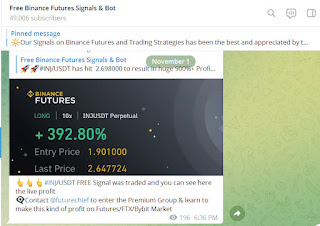##Bitcoin Smashes Past $26K as CPI Report Shows Inflation Held Steady in February
Binance Future Signals - https://binancefuturessignals.com/
Binance Future Signals - https://telegram.me/binancefuturesignal
Free Bitcoin Signals Mobile App -
https://play.google.com/store/apps/details?id=com.signalBroadcaster.FreeBitcoinSignals
Daily 4-5 Binance Futures, Bybit, Bitfinex, Kucoin, WazirX, Coinswitch, CoinDCX & Bitmex Crypto signals on Telegram in 2023 with an around 80-90% accuracy. All signals are provided by our Experts Team with proper take profit and proper stop loss including leverage & Regular updates are also provided for Traders which ensures they enter and close trades at accurate time
Best automated Binance Futures, Bybit, Bitfinex, Kucoin, WazirX, Coinswitch, CoinDCX BOT which is highly efficient and which execute trades in our live master accounts using our capital. Then through cutting edge technology, our Bot copies all your Signals via Cornix Bot on your Account. It is all automatic without any manual intervention
Bitcoin hit a nine-month high after annual inflation met economists’ estimates.
Bitcoin soared past $26,000, a price not seen since last Summer, on the back of the latest CPI print that showed inflation in the U.S. is still very much alive.
The Consumer Price Index (CPI) rose 6.0% in the 12 months through February, the Bureau of Labor Statistics (BLS) said Tuesday, meeting economists' expectations for the index, which tracks price movements across a broad range of goods and services.
Bitcoin and Ethereum jumped 5% and 4% to $26,295 and $1,778, respectively, according to CoinGecko. Other tokens, such as Dogecoin and Solana, also rose, adding to gains from Monday.'
Since setting a 41-year high of 9.1% last June, inflation has shown signs of easing but remains far above the Federal Reserve’s target of 2%.
On a month-to-month basis, prices rose 0.4% in February from January, matching economists’ forecast. The largest monthly gains to CPI came from food, recreation services, and shelter, which accounted for 70% of the monthly increase to CPI.
Shelter prices rose 0.8% from January to February, an 8.1% increase from a year ago. Energy prices fell 0.6% month-to-month after increasing by 2% in January.
Core CPI, which excludes volatile food and energy prices, came in slightly above economists’ expectations at 0.5% compared to 0.4%.
“Inflation is certainly not licked,” Chief Economist at Wells Fargo Jay Bryson told Decrypt, adding that core inflation is “still well above where the Fed would like to see it.”
To tame inflation, the Fed has aggressively raised interest rates, making it more expensive for businesses and consumers to borrow, and cooling the economy. Since it lifted interest rates from near zero last March, the Fed has taken interest rates to a target range of 4.50% to 4.75%—the highest since October 2007.
“If this would’ve printed well below expectations, they could’ve said ‘Okay, let's take a pause,’ given everything that’s happening in financial markets,” said Bryson in reference to the Fed. “But this complicates that a little bit.”
Last December, the Fed projected that interest rates would rise as high as 5.1% this year. And Fed Chairman Jerome Powell said earlier this month that rates would likely have to go higher, citing “economic data [has] come in stronger than expected” during congressional testimony.
But that was before the collapse of several U.S. banks last week.
Crypto-friendly Silvergate Bank said it was voluntarily winding down operations last Wednesday. Silicon Valley Bank then collapsed Friday, marking the second-largest bank failure in U.S. history. Signature bank, another crypto-friendly institution, was shut down by regulators on Sunday. The government has insisted, time and again, that depositors in Silicon Valley Bank and Signature would be made whole.
Had the U.S. banking sector not been thrust into a state of chaos, Tuesday’s inflation reading could’ve potentially led the Fed to continue raising interest rates at their meeting next week.
However, due to the possibility that Silicon Valley Bank’s troubles were a partial result of higher interest rates, the report’s sway isn’t as clear. U.S. Treasury Secretary Janet Yellen suggested Sunday that issues at Silicon Valley Bank were the result of “a higher interest rate environment” as opposed to issues with the tech sector.
Yesterday, cryptocurrency prices rose as investors recalibrated expectations of future rate hikes from the Fed. The possibility of the Fed raising interest rates by 50 basis points next week was wiped away as traders came to believe a pause was more likely.
"The news on the macro front does not fully explain why crypto markets continue to rally, especially considering the industry is still scrambling to find new banking partners after the closure of three crypto-friendly banks," Kaiko's head of research Clara Medalie told Decrypt. "Binance's announcement that they would liquidate 1 billion BUSD in exchange for BTC, ETH, and other assets is a strong catalyst of the recent price action. Overall, the recovery of USDC, Binance's BUSD announcement, and slowing inflation have triggered a market rally, but the industry faces significant headwinds."
Fed Futures markets anticipated Monday that the U.S. central bank would cut interest rates at some point soon, penciling in a 7% chance that interest rates are where they currently are or higher by the end of this year, far below the Fed’s projection of 5.1%.
The likelihood of the Fed putting a pause on interest rate hikes fell to 15% on Tuesday following the CPI report’s release, down from 35% the day before, according to the CME FedWatch Tool.
The likelihood of the Fed delivering a 25 basis point hike solidified at 85%.




Comments
Post a Comment